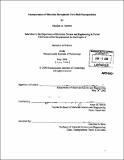| dc.contributor.advisor | Anne M. Mayes. | en_US |
| dc.contributor.author | Hewlett, Sheldon A | en_US |
| dc.contributor.other | Massachusetts Institute of Technology. Dept. of Materials Science and Engineering. | en_US |
| dc.date.accessioned | 2006-12-18T20:01:43Z | |
| dc.date.available | 2006-12-18T20:01:43Z | |
| dc.date.copyright | 2006 | en_US |
| dc.date.issued | 2006 | en_US |
| dc.identifier.uri | http://hdl.handle.net/1721.1/35067 | |
| dc.description | Thesis (S.B.)--Massachusetts Institute of Technology, Dept. of Materials Science and Engineering, 2006. | en_US |
| dc.description | Includes bibliographical references (p. 31-33). | en_US |
| dc.description.abstract | Core-shell baroplastics are nanophase materials that exhibit pressure-induced flow at low temperatures and high pressures. Core-shell baroplastics used in this work are comprised of a low Tg poly(butyl acrylate) (PBA) core and a high Tg polystyrene (PS) shell. These novel polymer systems can be molded into fully formed, 3-D shapes with the application of high pressure at room temperature. While the mechanical properties are equivalent to or better than those of commercial thermoplastic elastomers, more can be done to improve upon individual aspects of the mechanical properties, such as elastic modulus. This work looks at creating baroplastic nanocomposites with the goal of improving upon the mechanical properties. To accomplish this goal, two incorporation strategies for introducing silica nanoparticles were developed. The pre-emulsion strategy incorporated hydrophobized silica nanoparticles inside the core-shell nanoparticles to create core-shell-shell nanoparticles. The post-emulsion strategy incorporated charged silica nanoparticles after core-shell emulsion, with the intention of creating crystalline structures with silica and core-shell nanoparticles. | en_US |
| dc.description.abstract | (cont.) The pre-emulsion strategy resulted in a decrease in particle size for the core-shell-shell nanoparticles, as shown by dynamic light scattering. Excess silica in the emulsion resulted in phase separation and opaque, brittle samples. Samples made with this incorporation strategy showed poor mechanical properties. The post-emulsion strategy also resulted in poor processing. SAXS data show that there is no long range ordering with the SiO2 and core-shell nanoparticles. However, SAXS did show the possibility of a nanopcomposite with short range ordering of silica and core-shell particles. | en_US |
| dc.description.statementofresponsibility | by Sheldon A. Hewlett. | en_US |
| dc.format.extent | 33 p. | en_US |
| dc.format.extent | 1356517 bytes | |
| dc.format.extent | 1355580 bytes | |
| dc.format.mimetype | application/pdf | |
| dc.format.mimetype | application/pdf | |
| dc.language.iso | eng | en_US |
| dc.publisher | Massachusetts Institute of Technology | en_US |
| dc.rights | M.I.T. theses are protected by copyright. They may be viewed from this source for any purpose, but reproduction or distribution in any format is prohibited without written permission. See provided URL for inquiries about permission. | en_US |
| dc.rights.uri | http://dspace.mit.edu/handle/1721.1/7582 | |
| dc.subject | Materials Science and Engineering. | en_US |
| dc.title | Incorporation of silica into baroplastic core-shell nanoparticles | en_US |
| dc.type | Thesis | en_US |
| dc.description.degree | S.B. | en_US |
| dc.contributor.department | Massachusetts Institute of Technology. Department of Materials Science and Engineering | |
| dc.identifier.oclc | 71230020 | en_US |
